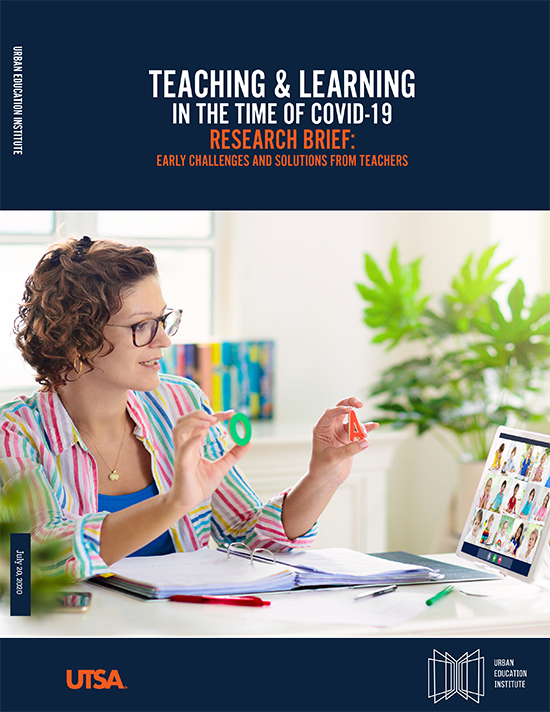
JULY 20, 2020 — At a time when almost everything about the next school year is uncertain, UTSA’s Urban Education Institute sees a path forward.
Mike Villarreal, director of the Urban Education Institute, and his team have spent the summer surveying almost 2,000 K–12 public school students, parents and teachers across seven Bexar County school districts and one local network of career-themed schools to find out what worked and what didn’t during pandemic distance learning. Their findings are helping inform the districts as administrators and teachers plan fall learning.
“There are very high levels of anxiety right now and it’s understandable,” Villarreal said. “Schools are hearing from teachers that they fear for their health if they have to go back inside classrooms with students, and they’re hearing from many parents who want their kids back full-time. We have vulnerable students who have experienced trauma amid food insecurity, grief and loss. There are no easy answers and there is so much at stake, but our school districts and institute have learned a lot from last spring.”
 The findings in the report, “Teaching and Learning in the Time of COVID-19,” are helping inform current local planning on improving distance learning for the fall by participating schools. Superintendents and administrators are using the analysis to create evidence-based strategies strengthening remote learning.
The findings in the report, “Teaching and Learning in the Time of COVID-19,” are helping inform current local planning on improving distance learning for the fall by participating schools. Superintendents and administrators are using the analysis to create evidence-based strategies strengthening remote learning.
This research, which focuses on public school teacher experiences and recommendations, is the first brief in a series coming out of the comprehensive survey. The next release this summer will look more deeply at what parents and students said they’d like to see in any future distance or hybrid-blended learning approaches.
Some of the key findings of this first brief include:
Teachers are adapting and figuring out distance learning, but they need more planning time and training.
Students were significantly less engaged during early distance learning.
The report also has research-based recommendations to improve distance learning from teachers. If schools stay virtual in the fall, teachers say these things must occur for learning to be meaningful and relevant:
⇒ Explore the work of the Urban Education Institute at UTSA.
School districts participating in the research project represent some of the largest and most diverse in the city. They include East Central, Edgewood, Harlandale, Judson, Northside, North East and Southwest. An eighth set of schools that partner with traditional public school districts known as the Centers for Applied Science and Technology Network also participated.
“It’s important to note that our schools were forced into what we now refer to as ‘emergency distance learning’ in the spring,” Villarreal said. “The vast majority of them were not equipped for such sweeping and sudden changes. With these findings, we are giving schools best practices to follow for the fall so that students are more engaged and teachers are more empowered. It’s exciting to witness the adaptability and dedication that most everyone involved in education is showing. It’s reshaping the modern classroom and our research aims to make sure that it’s all for the better.”
UTSA Today is produced by University Communications and Marketing, the official news source of The University of Texas at San Antonio. Send your feedback to news@utsa.edu. Keep up-to-date on UTSA news by visiting UTSA Today. Connect with UTSA online at Facebook, Twitter, Youtube and Instagram.
Move-in Day is an exciting time for incoming students. Students living in Chaparral Village move in from August 20-21. The UTSA Housing and Residence Life (HRL) team looks forward to welcoming you all and helping you settle into your room.
Chaparral VillageMove-in Day is an exciting time for incoming students. Students living in Laurel Village move in on August 22. The UTSA Housing and Residence Life (HRL) team looks forward to welcoming you all and helping you settle into your room.
Laurel VillageThe College of Sciences welcomes our newest Roadrunners to UTSA at VIVA Science! This interactive event connects students with faculty, staff, student leaders, and peers while highlighting the opportunities available across the College.
Outdoor Learning Environment 2 (OLE), Flawn Building, Main CampusWe're excited to welcome the new class of UTSA College of Liberal and Fine Arts (COLFA) students to campus! Move In To COLFA is strongly recommended for new students in COLFA because it gives you the chance to learn about the Student Success Center, learn how to do college successfully and meet new friends.
Galleria (MH 2.01), McKinney Humanities Building, Main CampusBuild connections with your Alvarez College of Business peers and learn more about the Career Compass program! This opportunity will provide fun interactions, giveaways and a chance to meet your next friend!
Richard Liu Auditorium (BB 2.01.02,) Business Building, Main CampusCelebrate the end of summer and the start off a great fall semester with The Housing Block Party! This event will have live music, carnival-style treats, artists, games, and activities galore. Come and join us for a night of fun!
Multipurpose Room/Lawn, Guadalupe Hall, Main CampusBe part of an unforgettable night as SOSA takes the field for its first public performance of the season! Experience the power, pride, and pageantry of UTSA’s marching band. Learn beloved traditions, practice cheers, and feel what it means to be a Roadrunner.
Campus Rec FieldsThe University of Texas at San Antonio is dedicated to the advancement of knowledge through research and discovery, teaching and learning, community engagement and public service. As an institution of access and excellence, UTSA embraces multicultural traditions and serves as a center for intellectual and creative resources as well as a catalyst for socioeconomic development and the commercialization of intellectual property - for Texas, the nation and the world.
To be a premier public research university, providing access to educational excellence and preparing citizen leaders for the global environment.
We encourage an environment of dialogue and discovery, where integrity, excellence, respect, collaboration and innovation are fostered.